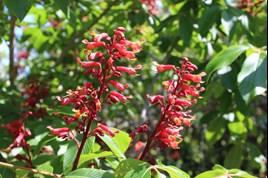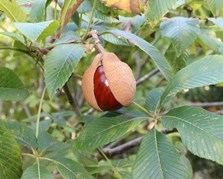

Mississippi Native: Buckeyes
(Aesculus pavia)
Downloadable Brochure: BUCKEYES
Other Name/s:
Red Buckeye, Scarlet Buckeye, and Firecracker Plant
Description/Season:
This perennial shrub/tree displays red, bell-shaped flowers, and blooms in the spring (March – April). The buckeye tree has a rounded appearance. This plant’s leaves are a glossy, dark green on the topside but white and hairy underneath. These leaves are comprised of 5 leaflets, which turn yellow in the fall.
Seeds begin forming in the summer and through the fall. In the fall, the seeds are found dispersed under the plant. These seeds are shiny and reddish-brown.
Size:
Flowers are 1 – 1 1/2 inches long; clusters are 6 – 10 inches long, and the plant itself usually reaches heights of no more than 10 feet. Nuts are usually 1 – 2 inches long. Leaflets can be as long as 6 inches with the stem measuring the same length.
Habitat:
Native to Mississippi, the red buckeye is found near the banks of streams, creeks, and rivers in well-drained areas.
Buckeyes and Fishing Past:
Native Americans used buckeye seeds to retrieve fish by grinding up seeds and throwing them in the water to stun the fish. Fish floated to the surface, making it easy for the Native Americans to harvest them. This way of fishing is illegal now.
The Choctaw also used buckeye as a poison for arrows during warfare.
Planting Tips:
Plant from root cuttings or seeds. Plant seeds quickly while they are still firm due to their quick degeneration. This plant needs full sun to part shade. The buckeye needs moist, well-drained soil. The red buckeye dislikes dry soil, thus fairs poorly in droughts.









